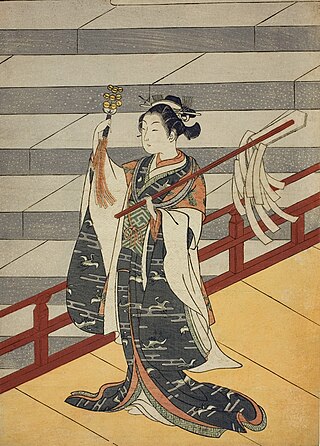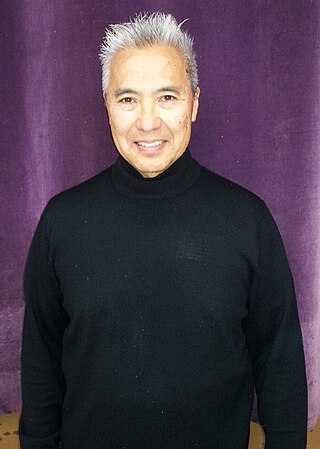
Taiko are a broad range of Japanese percussion instruments. In Japanese, the term taiko refers to any kind of drum, but outside Japan, it is used specifically to refer to any of the various Japanese drums called wadaiko and to the form of ensemble taiko drumming more specifically called kumi-daiko. The process of constructing taiko varies between manufacturers, and the preparation of both the drum body and skin can take several years depending on the method.

Obon or just Bon is a fusion of the ancient Japanese belief in ancestral spirits and a Japanese Buddhist custom to honor the spirits of one's ancestors. This Buddhist–Confucian custom has evolved into a family reunion holiday during which people return to ancestral family places and visit and clean their ancestors' graves when the spirits of ancestors are supposed to revisit the household altars. It has been celebrated in Japan for more than 500 years and traditionally includes a dance, known as Bon Odori.

Kitarō (喜多郎), born Masanori Takahashi, is a Japanese recording artist, composer, record producer, and arranger noted for his electronic-instrumental music, and is often associated with and regarded as one of the most prominent musical acts of new-age music. He won the Grammy Award for Best New Age Album for Thinking of You (1999), with a record 16 nominations in the same category. He received a Golden Globe Award for the original score to Heaven & Earth (1993).
Yamatai is a student-run taiko drumming team at Cornell University. Based in Cornell's Lincoln Hall, they perform for several events on campus and in the northeast region of the United States.

Kodō (鼓童) is a professional taiko drumming troupe. Based on Sado Island, Japan, they have had a role in popularizing taiko drumming, both in Japan and abroad. They regularly tour Japan, Europe, and the United States. In Japanese the word "Kodō" conveys two meanings: "heartbeat" the primal source of all rhythm and, read in a different way, the word can mean "children of the drum".

Ondekoza (鬼太鼓座), sometimes referred to as "Za Ondekoza", is a Japanese troupe specializing in taiko drumming.

Kagura is a type of Shinto ritual ceremonial dance. The term is a contraction of the phrase kami no kura, indicating the presence of gods in the practice.

Rick Shiomi is an internationally recognized, award-winning Japanese Canadian playwright, stage director, artistic director and taiko artist, and a major player in the Asian American/Canadian theatre movement. He is best known for his groundbreaking play Yellow Fever, which earned him the Bay Area Theater Circle Critics Award and “Bernie” Award. Over the last couple decades, Shiomi has also become a notable artistic and stage director. He directed the world premiere of the play Caught by Christopher Chen for which he received the Philadelphia Barrymore Award Nomination for Outstanding Direction. He is currently the Co-Artistic Director of Full Circle Theater Company.

Kenny Endo is an American musician and taiko master. He is the leader of several taiko ensembles and regularly tours, performing traditional and contemporary taiko music. Endo is also the first non-Japanese national to receive a natori in the field of hogaku hayashi, Japanese classical drumming. Today Endo composes his own music and plays taiko professionally as a solo artist, with his ensembles, and in collaboration with other artists.

Patti Jo "PJ" Hirabayashi is one of the pioneers of the North American Taiko movement. She is the founder of TaikoPeace, President of Kodo Arts Sphere America (KASA), and co-founder of Creatives for Compassionate Communities-a grassroots art-ivist group originating in San Jose, California. She is also the Artistic Director Emeritus and charter member of San Jose Taiko, the third taiko group to form in the United States. Her signature composition, "Ei Ja Nai Ka", is a celebration of immigrant life expressed in taiko drumming, dance, and voice that continues to be performed around the world.

Roy Hirabayashi is a leader in North American Taiko. He is a composer, performer, teacher and activist. He is co-founder of one of the seminal taiko groups in North America, San Jose Taiko, the group's former Artistic and Executive Director, and active in developing San Jose's Japantown and arts community.
Stanford Taiko is a collegiate taiko group based at Stanford University. One of the first collegiate taiko groups to form in North America, it was founded in the winter of 1992 by students Ann Ishimaru and Valerie Mih as a way to share taiko with the university community. As the founding organization of the Intercollegiate Taiko Invitational, Stanford Taiko has been instrumental in the development of collegiate taiko throughout the United States, as well as the larger North American taiko community through performing at the Taiko Jam of the North American Taiko Conference. Since 2000, the group has been active in the international scene through tours and exchange concerts in countries such as Japan, China, and Thailand.
The Midwest Buddhist Temple Taiko group is a self-taught taiko group based in Chicago, Illinois, at the Midwest Buddhist Temple. The group started in 1977 based upon Buddhistic principals after the model of Kinnara Taiko in Los Angeles. The Midwest Buddhist Temple Taiko group performs for the temple, the Buddhist community, the Japanese American community, other communities, commercial gigs, business conferences, and different ethnic fairs. They do not consider themselves to be primarily a performing group, and they do service projects with the temple such as performing at the Midwest Buddhist Temple Ginza Holiday Festival.
Denver Taiko is the fourth taiko group founded in North America and the first taiko ensemble outside of California, United States. The group has a close partnership with the Tri-State Denver Buddhist Temple and performs throughout Colorado and neighboring states. In 2001, Denver Taiko received the Excellence in the Arts Award from Denver Mayor Wellington Webb. Today, Denver Taiko is an ensemble of third, fourth, and fifth generation Japanese Americans with a shared interest in honoring their Japanese American cultural heritage.
UCLA Kyodo Taiko is a collegiate taiko group specializing in taiko drumming. Founded in 1990, Kyodo is the first collegiate taiko group in the country. Kyodo is a Japanese term that means both "family" and "loud children." Many of Kyodo’s members are not of Japanese descent.
Kinnara Taiko is a Japanese American drumming ensemble based out of Senshin Buddhist Temple in Los Angeles, USA. They began playing taiko in 1969 when a few third-generation Japanese Americans gathered after an Obon festival and had an impromptu experimental session on an odaiko drum.

Yatai-bayashi is a traditional taiko piece inspired by an annual festival in Chichibu, Japan. The piece been performed by many taiko ensembles, and became well-known through dramatic variations of the piece developed by Ondekoza and Kodo. Yatai-bayashi has been recognized as a piece that requires great physical endurance.
The Senshin Buddhist Temple is a Buddhist temple in Los Angeles, California. An affiliate of the Buddhist Churches of America (BCA), the temple was built in 1951. It is known for its maintenance of traditional practices and for cultivating one of the earliest taiko groups appearing in the United States under the leadership of Masao Kodani.

Eitetsu Hayashi is an acclaimed Japanese musician best known for his solo performance work in taiko. Hayashi joined the group Ondekoza at an early age. Later, after parting from group, helped found the taiko group Kodo, though he quickly left to begin a solo career. Hayashi has performed in notable venues such as Carnegie Hall in 1984 and was the first featured taiko performer at the institution. He is also the recipient of multiple awards recognizing the cultural value of his work.
Osuwa Daiko (御諏訪太鼓) is a Japanese percussion group credited as the earliest groups to develop and perform the ensemble-style of taiko called kumi-daiko. Formed in Okaya, Japan in 1951 and founded by Daihachi Oguchi, Osuwa Daiko created a style of performance independent from performance during festivals, theatrical performance, and religious ceremonies, and transformed them into an ensemble performance. Contemporary taiko performance in Japan and in the rest of the world is widely based on the practices of Osuwa Daiko.










